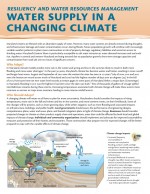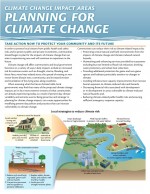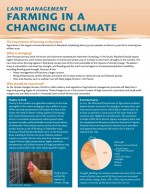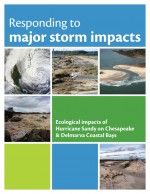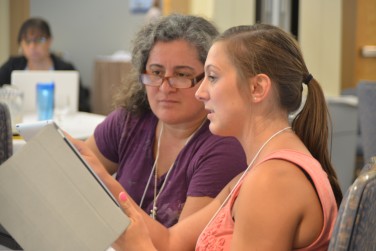 Communicating complex scientific concepts and findings in a way that is understandable to a broad and diverse public audience will advance efforts to increase public engagement in climate science, climate change consequences, and mitigation and adaptation opportunities. Communication is critical to instigate the needed large-scale change. Local and national decision-makers represent the people, but the people must convince them of the importance of climate change planning. Effectively informing the public requires engaging multiple generations. We not only need to reach adults, but also today’s children. Students are in positions to affect change, and will be tomorrow’s decision-makers. The Next Generation Science Standards provide the opportunity to reach this generation, but science teachers need to be informed themselves to bring climate science into the classroom.
Communicating complex scientific concepts and findings in a way that is understandable to a broad and diverse public audience will advance efforts to increase public engagement in climate science, climate change consequences, and mitigation and adaptation opportunities. Communication is critical to instigate the needed large-scale change. Local and national decision-makers represent the people, but the people must convince them of the importance of climate change planning. Effectively informing the public requires engaging multiple generations. We not only need to reach adults, but also today’s children. Students are in positions to affect change, and will be tomorrow’s decision-makers. The Next Generation Science Standards provide the opportunity to reach this generation, but science teachers need to be informed themselves to bring climate science into the classroom.
The MADE CLEAR program promotes three core pieces of communication.
- MADE CLEAR serves as a platform for educators to discuss and develop shared messages and to recommend resources for incorporating climate science into curriculums through an informal education Community of Practice.
- MADE CLEAR strives to communicate an understanding of teaching strategies that work for different demographic populations.
- MADE CLEAR is leading the Climate Communication Consortium of Maryland whose goal is to use local public opinion data on climate perceptions and knowledge of climate change to develop messages and education and outreach strategies. The Consortium facilitates collaboration in the communication efforts of government agencies and elected officials, businesses, non-profit organizations, advocates and citizens. For more information, visit http://climatemaryland.org.
The following publications and websites can serve as resources that offer general communication strategies as well as specific examples of climate communication.
THE EmPOWERS Activity Kit includes five activities that help educators talk about the intersections of energy and climate in their afterschool program, classroom, church, library, or at home. Instructions are provided for each activity, and there is also an additional resource page if educators want to go beyond this initial introduction. THE EmPOWERS were created to teach youth (and adults) about the different types of energy sources that provide us with electricity in Maryland. THE EmPOWERS can be found throughout the kit providing helpful tips and information. Check out more information about each of THE EmPOWERS in the section “Meet THE EmPOWERS.”
Climate Change Topics: Energy
Tags: Technology Resources
Published: December, 2015
Details: PDF (6 MB, 82 pages)
Maryland citizens are blessed with an abundant supply of water. However, many water systems are already stressed during droughts, and infrastructure damage and water contamination occurs during floods. Future population growth will combine with increasingly variable weather patterns to place more communities at risk of property damage, regulatory liabilities and uncertain access to drinking water. This brochure outlines multiple management practices that local, state, and private citizens should consider implementing to reduce risk and build resilience.
Climate Change Topics: Adaptation, Extreme Weather, Urban Impacts, Agriculture
Published: July, 2013
Details: PDF (2.3 MB, 4 pages)
The CLEAN project, a part of the National Science Digital Library, provides a reviewed collection of resources coupled with the tools to enable an online community to share and discuss teaching about climate and energy science.
Climate Change Topics: Communication
Temperature and precipitation trends in Maryland have been increasing over the past 30 years. Storm surges, wetland loss, erosion, droughts and sea level rise are among the major local threats, but planning for climate change can reduce the risks to Maryland’s environment and residents. Examples include restoring natural buffers, prohibiting development in sea level rise inundation zones, and creating water management plans to account for wider variations in flow.
Climate Change Topics: Communication, Adaptation, Sea Level Rise, Extreme Weather, Urban Impacts, Engineering
Published: May, 2013
Details: PDF (2.4 MB, 4 pages)
Agriculture represents a major portion of land use in Maryland, and is a significant contributor to Maryland’s economy. Maryland’s agricultural community is particularly susceptible to the effects of climate change. Higher temperatures, greater storm events, more severe droughts, and sea level rise will lead to increased flooding, pests, unproductive crops, and animal disease and mortality. Several planning tools are available to farmers and land and natural resource managers, including the Maryland Department of Natural Resources Climate Change Impact Area Mapper and a variety of management practices to reduce risk and control negative climate change impacts.
Climate Change Topics: Communication, Adaptation, Sea Level Rise, Extreme Weather, Agriculture
Published: May, 2013
Details: PDF (922 KB, 4 pages)
A rapid ecological assessment of Hurricane Sandy’s impacts on the Chesapeake Bay and Delmarva Coastal Bays was conducted using data provided by scientists from government agencies, non-government organizations, and academic institutions. A synthesis of these data revealed both negative and potentially positive effects on the ecological systems. Several recommendations for mitigation activities were made to help inform U.S. congressional leadership and the general public.
Climate Change Topics: Extreme Weather, Urban Impacts, Communication, Ecological Systems
Tags: Hurricane, Storm, Sea-level Rise
Published: December, 2012
Details: PDF (6.4 MB, 20 pages)
Shifting Conditions on Assateague will Impact Nature and People Alike. As global temperatures and sea-level continue to rise, some organisms may thrive on Assateague while others may be replaced by more tolerant species. As storms intensify, the rate at which Assateague will experience overwash and island rollover will increase. Ultimately, very different landscapes may change the access and experience that visitors enjoy today.
Published: October, 2012
Details: PDF (3 MB, 2 pages)
Published: November, 2009
Details: PDF (9.7 MB, 1 page)
www.climatecommunication.org. Climate Communication is a project of the nonprofit organization Aspen Global Change Institute, and is funded by the Rockefeller Brothers Fund and the ClimateWorks Foundation. Climate Communication focuses on three major activities. They publicize climate change to the public and policy makers in plain language to make science more accessible, support scientists in improving communication and outreach skills through professional meetings and labs, and assist journalists in using reliable scientific information and identifying climate experts.
Find a Publication
Leave filter options blank for all


